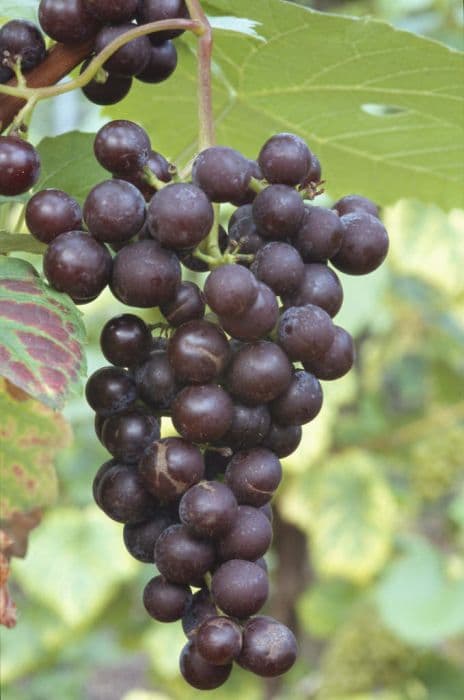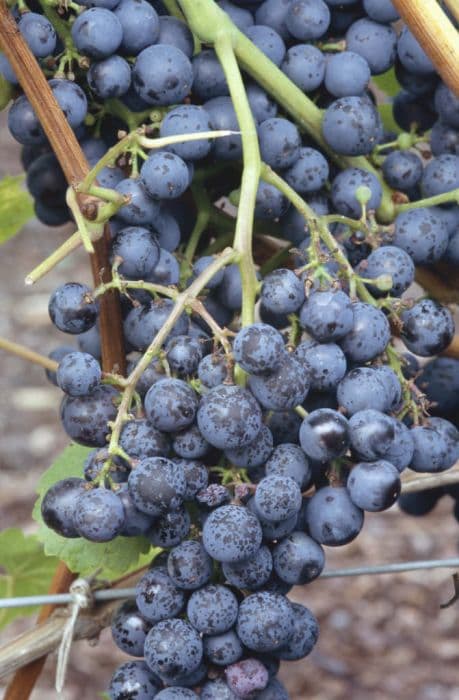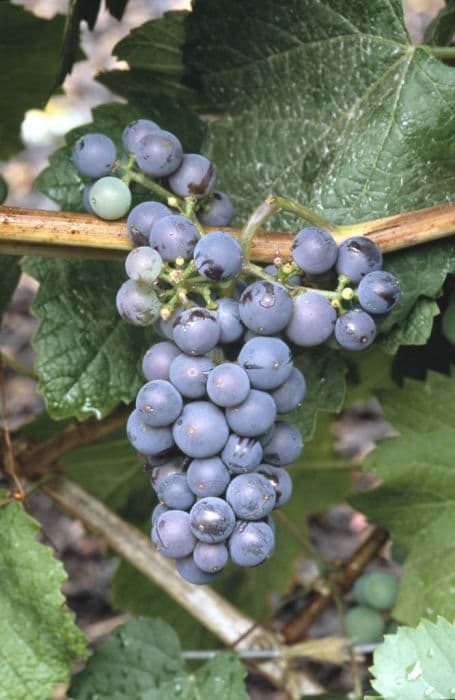New York Muscat Grape Vitis 'New York Muscat' (O/b)

ABOUT
Vitis 'New York Muscat' is a type of grapevine known for its grape production used in winemaking and fresh consumption. The vine typically showcases robust and woody stems that intertwine and climb, seeking support to grow. Its foliage is lush and green, with leaves that are broad and deeply lobed, often with toothed edges. During the growing season, the leaves provide a dense and vigorous canopy for the developing grape clusters. The most striking feature of the 'New York Muscat' is its grape clusters, which are medium to large and conical in shape, carrying a number of round to slightly oblong berries. The grapes themselves are a dark purple to almost black hue when ripe and are known for their rich and musky aroma, a characteristic highly prized by grape enthusiasts. This unique and intense scent is often reflected in the flavor of the wines or juices made from these grapes. Additionally, the skin of these grapes can be relatively thick, which adds to the texture of the fruit when consumed fresh. Throughout the growing season, the plant also displays tendrils, which are used to grasp onto any available support, allowing the vine to climb effectively. The flowers of the 'New York Muscat' grapevine are small and inconspicuous, typically appearing in early summer and are pollinated to produce the fruit that is harvested later in the season. As the season progresses, the foliage may change color, taking on golden or reddish hues during the autumn months, adding an ornamental value to the vineyard or garden where it grows. The contrast between the mature foliage and the ripe grape clusters can make for a visually appealing display.
About this plant
 Names
NamesFamily
Vitaceae
Synonyms
New York Muscat Vine, New York Muscat Grape
Common names
Vitis 'New York Muscat'.
 Toxicity
ToxicityTo humans
The plant in question is commonly known as grape, specifically a variety of grape. Grape plants (both the fruit and other parts like leaves and vines) are not generally toxic to humans, and in fact, they are widely consumed in various forms, such as fresh fruit, juice, and wine. However, some individuals may have allergic reactions to grapes or products made from grapes. In very rare cases, the grape skins might be treated with chemicals which could be harmful if ingested in large quantities. Always ensure that grapes are properly washed before consumption and obtained from a reputable source to minimize any potential risks.
To pets
The common name of Vitis 'New York Muscat' is grape; this plant can be highly toxic to pets, especially dogs and cats. Ingesting grapes can cause sudden kidney failure in these animals. The exact toxic compound is not well understood, but even a small amount can be dangerous. Symptoms of poisoning in pets may include vomiting, lethargy, diarrhea, reduced appetite, abdominal pain, decreased urine production, or kidney failure, which can be fatal. If you suspect your pet has ingested grapes, contact your veterinarian immediately, as this is an emergency situation.
 Characteristics
CharacteristicsLife cycle
Perennials
Foliage type
Deciduous
Color of leaves
Green
Flower color
Greenish
Height
5-8 feet (1.5-2.4 meters)
Spread
5-8 feet (1.5-2.4 meters)
Plant type
Climber
Hardiness zones
5-8
Native area
North America
Benefits
 General Benefits
General Benefits- Edible Fruits: The plant produces grapes that are used for making wine, juices, and jellies.
- Aesthetic Appeal: With its lush foliage and clusters of grapes, it adds beauty to gardens and landscapes.
- Shade Provider: Its canopy can create shaded areas in gardens, providing cool spaces during warmer months.
- Habitat for Wildlife: It provides food and shelter for birds and other wildlife.
- Erosion Control: The plant's root system helps to stabilize soil and prevent erosion.
- Pollinator Attraction: The flowers of the grape vine attract bees and other pollinators, that are important for the ecosystem.
- Educational Interest: It offers opportunities for learning about viticulture, the process of growing grapes, and wine-making.
 Medical Properties
Medical PropertiesThis plant is not used for medical purposes.
 Air-purifying Qualities
Air-purifying QualitiesThis plant is not specifically known for air purifying qualities.
 Other Uses
Other Uses- Natural dye: The skins of 'New York Muscat' grapes can be used to create a natural dye for fabrics or food coloring due to their deep purple hue.
- Photography: The rich color and textures of the grape clusters can be used as subject matter for still life photography, providing an aesthetically pleasing composition due to their vibrant color.
- Grape seed crafts: The seeds from 'New York Muscat' grapes can be dried and used in various crafts, such as homemade jewelry or mosaics.
- Culinary decoration: Fresh or dried 'New York Muscat' grape leaves can be used to add a touch of elegance in plating and presenting food dishes.
- Garden composting: Discarded parts of the 'New York Muscat' grapevine, such as pruned branches and leaves, can be composted to enhance soil quality in gardens.
- Printing with grape juice: The juice from 'New York Muscat' grapes can be used as a natural ink for arts and crafts, such as block printing on paper or fabrics.
- Educational tool: The 'New York Muscat' grapevine can be used to teach children or gardening enthusiasts about plant growth, fruit development, and horticulture practices.
- Floral arrangements: When in bloom, the 'New York Muscat' grapevine flowers can be included in floral arrangements for their subtle beauty and fragrance.
- Grape leaf pillows: Dried grape leaves from the 'New York Muscat' plant can be used to stuff small decorative pillows or sachets.
- Biofuel research: Though not a conventional use, the biomass of 'New York Muscat' grapevines could potentially be studied for use in biofuel production.
Interesting Facts
 Feng Shui
Feng ShuiThe Grapevine is not commonly used in Feng Shui practice.
 Zodiac Sign Compitability
Zodiac Sign CompitabilityThe Grapevine is not used in astrology practice.
 Plant Symbolism
Plant Symbolism- Fertility: As a grapevine, New York Muscat symbolizes abundance and fertility, reflecting the prolific nature of grapevines which are known for their lush growth and plentiful fruit.
- Transformation: Grapes undergo a transformation to become wine, symbolizing change and the ability to evolve or alter one's state of being.
- Prosperity: Historically, owning a vineyard was a sign of wealth, so grapevines like the New York Muscat can represent prosperity and success.
- Celebration: Grapes and wine are often associated with celebrations and gatherings, thus the grapevine typifies joy, festivity, and communal sharing.
- Vitality: The robust nature of the grapevine and the health benefits of grapes and wine signify life and vitality.
 Water
WaterThe New York Muscat grapevine should be watered deeply, ensuring that the water reaches the roots. During the growing season, it's vital to maintain consistent soil moisture, so watering should be done once a week with about 1 inch of water, which approximately translates to 0.6 gallons for an average-sized vine; however, this could vary depending on soil type and weather conditions. Always check the soil before watering; if the first 2 inches are dry, it's time to water. During the dormant season, reduce the frequency but do not allow the soil to completely dry out.
 Light
LightThe New York Muscat grapevine requires full sunlight to thrive, with a preference for at least 6 to 8 hours of direct sunlight each day. The best spot for planting is in an area that receives unobstructed sunlight throughout the day, as grapes rely on ample sunlight for sugar production, which is critical for the ripening of the fruit.
 Temperature
TemperatureThe New York Muscat grapevine thrives in a temperature range between 50°F and 85°F for optimal growth. It can survive minimum temperatures in the range of -10°F to 0°F, showing decent cold hardiness. The ideal growing conditions for this grapevine include warm and dry summers and cool winters. Prolonged exposure to temperatures above 95°F may stress the vine and hinder fruit development.
 Pruning
PruningPruning is crucial for maintaining the health and productivity of the New York Muscat grapevine. It should be pruned annually during late winter when the plant is dormant but before the buds start to swell, usually between January and March. Pruning helps to regulate fruit production, improve air circulation, and shape the vine. Remove old growth and thin out crowded areas to encourage the development of new fruiting wood.
 Cleaning
CleaningAs needed
 Soil
SoilNew York Muscat grape vines flourish in well-draining, loamy soil with a pH of around 5.5 to 6.5. A soil mix containing two parts loam, one part sand, and one part compost or aged manure will provide the necessary nutrients and drainage the grapes need to thrive.
 Repotting
RepottingGrape vines like New York Muscat typically do not need frequent repotting as they are usually planted directly in the ground. If grown in containers, repotting every 2-3 years or when the plant outgrows its current pot is sufficient.
 Humidity & Misting
Humidity & MistingNew York Muscat grapes prefer moderate humidity levels but are adaptable to various conditions. It is crucial to ensure good air circulation around the plants to reduce the risk of fungal diseases.
 Suitable locations
Suitable locationsIndoor
Grow New York Muscat grapes indoors with ample light and strong support for vines.
Outdoor
Plant in full sun, train on sturdy trellis or arbor, and mulch well.
Hardiness zone
5-8 USDA
 Life cycle
Life cycleThe life of the New York Muscat grape begins with the germination of seeds or the rooting of cuttings, which establish a new vine. Following the establishment, the vine enters a growth phase where it develops a strong root system, trunk, and canes, with leaves unfurling to photosynthesize and support growth. The grape then enters a flowering stage, typically in late spring, where pollination occurs, either through self-pollination or with the help of insects. After successful fertilization, small green grape berries form and enter a period of rapid growth and development through the summer. These berries ripen, changing color and accumulating sugars, until they reach full maturity in late summer or early fall, a stage known as veraison. Finally, the mature grapes are harvested, and the vine prepares for dormancy through the winter, only to begin the cycle anew with bud break in the following spring.
 Propogation
PropogationPropogation time
Spring to Summer
The 'New York Muscat' grape, a variety known for its aromatic and flavorful fruit, is typically propagated through hardwood cuttings. This method is favored due to its simplicity and effectiveness. In winter, when the vine is dormant, select healthy canes from the previous year's growth. Cut these into lengths of about 12 to 18 inches (30 to 45 cm), ensuring each cutting has at least two to three buds. Plant the cuttings in well-drained soil, burying at least two buds beneath the surface to encourage root development. Maintaining consistent moisture and protecting the cuttings from extreme temperatures will promote successful rooting and growth in the following season.









